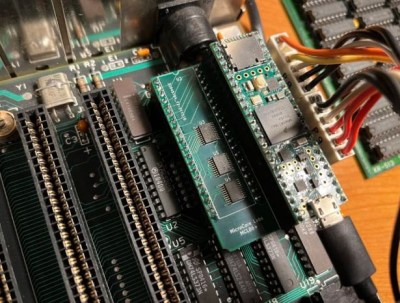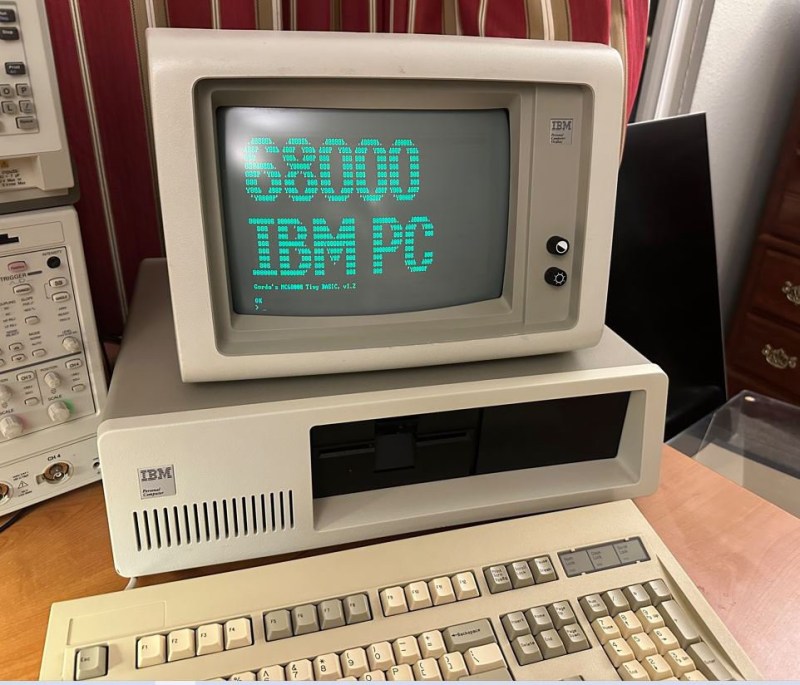Although ARM CPUs have been making headway in several areas of computing over the last decade or so, the vast majority of desktop, laptop and server CPUs are still based on the x86 architecture. How that came to be is no secret, of course: IBM chose the Intel 8088 to power its model 5150 PC back in the early 1980s, and since it became the dominant PC platform, everyone else followed suit. But what if IBM’s purchasing department had got a good deal at Motorola instead? [Ted Fried] has been experimenting with that scenario, by equipping an IBM PC with a 68000 CPU.
To be fair, he didn’t use an actual Motorola chip; instead, he emulated a 68k core on a Teensy 4.1 and implemented the 8088’s bus interface on its pins. The emulated core does exactly the same thing an actual CPU would do, while the rest of the computer works the same way it always did – data is stored in the motherboard’s DRAM chips, keystrokes are processed by the standard 8255 chip and progam output is displayed on the monitor through the MDA video card.
 The biggest problem inherent in performing such a heart transplant is that there’s no software for the resulting system: standard PC programs won’t run on the CPU, while software made for 68000-based computers can’t handle the IBM’s input and output devices. [Ted] therefore decided to use 68000 Tiny Basic, which is a minimalist version of BASIC designed for 68000-based single-board PCs, and adapt it to his specific use case. As you can see in the video embedded below, it works perfectly fine: the PC might as well have been running plain old Microsoft BASIC.
The biggest problem inherent in performing such a heart transplant is that there’s no software for the resulting system: standard PC programs won’t run on the CPU, while software made for 68000-based computers can’t handle the IBM’s input and output devices. [Ted] therefore decided to use 68000 Tiny Basic, which is a minimalist version of BASIC designed for 68000-based single-board PCs, and adapt it to his specific use case. As you can see in the video embedded below, it works perfectly fine: the PC might as well have been running plain old Microsoft BASIC.
While the new CPU should be quite a bit faster than the original Intel chip, a side-by-side performance comparison shows little improvement in the PC’s overall speed. But it’s nevertheless an interesting experiment, and it makes you wonder what today’s PCs would look like, had IBM chosen a different CPU back then. How they settled on the 8088 is actually a fascinating story in itself.

















About thirty years ago there was a 68000 project in Radio Electronics, written by Peter Stark. I don’t think he designed it. It had an ISA bus and used IBM peripherals like the keyboard and videocards. And it used a real 68000, or maybe by then a later variant.
The irony being, ARM had it’s genesis as a desktop CPU. ARM = Acorn RISC Machine, the project by Acorn to develop their own CPU as a successor to the 6502, finding other chips available (e.g. 68000) were either not fast enough or did not feature the IO performance they wanted. The Acorn desktop PC line was not a huge success, but the ARM chip itself was shopped around many devices before ARM started licensing the core for inclusion in other chips.
Reminds me of the Acorn Archimedes. The Arthur OS that was originally used was fascinating.
https://m.youtube.com/watch?v=VK5AZrg3ZD8&t=275
IBM engineers actually wanted to use the 68000 for the PC but management said no (mostly on the basis that the 68000 was new and Motorola would not have been able to produce the quantities IBM was looking for and the high cost that would have been required for the board and support chips that the 68000 would have needed in order to work)
A 68000-based PC would probably have eventually ended up looking like a 68K mac.
Sun Microsystems did have their Sun-1(1982), Sun-2(1983) and Sun-3(1985) based workstations, all used Motorola 68000 series of processors. Up until 1987 when Sun switched to their own SPARC (Scalable Processor ARChitecture) processors.
A *LOT* of unix workstations ran on the 68000 and it’s accompanying MMU unit until the RISC craze started and all the big players started developing their own RISC chips.
The original 68k based ones typically used a custom mmu (because motorola didn’t supply one until later on), and often needed two 68k chips due to a design issue that wasn’t fixed until the 68010
IBM introduced a 68000-based computer in 1982, the System 9000. It was focused on laboratory applications and did not sell well.
I remember the IBM 9000 was used as a control station for their HPLC machines – a division which was later sold to Nicolet. The 9000 was supposed to get a multitasking OS and to be able to control and gather data from multiple HPLCs. IBM never produced the promised OS. The 9000 also had an atrociously unreliable integrated color dot matrix printer which appeared to use guts made by the shortly to be defunct Tigertronics.
At the time I taught a laboratory informatics course which because of lack of consistent PC environment for students in 1983, used BASIC for the programming assignments. One of my students used his lab’s IBM 9000 for assignments. An early assignment compared looping with IF statements with FOR/NEXT. The task was to add 1 to a variable 16 times. In floating point, the BASIC on the IBM 9000 gave the result 15.9! It was an interesting lesson in unexpected pitfalls and to not blindly trust results of computations without prior testing.
The Corvus Concept was a 68000-based PC, featuring a a monitor that switched between portrait and landscape modes, via an embedded mercury switch.
Well there is always CP/M 68k for an OS or you could take a look at any of the TOS clones available and port it.
I remember back then The common opinion at the time was if you had to run Fight Simulator and Lotus 1-2-3 if you didn’t you used a 68000. A lot of computers back then did use the 68000, Radio Shack Model 16, Amiga, Atari ST, Apple Mac, Sage Micro, many workstations, the HP Laserjet, and what they used to call Supermicros “before the systems integrator existed”.
IBM didn’t choose it for a couple of the reasons all of them bad IMHO. The 68000 was only available as a ceramic DIP and not a plastic DIP until later. Some say that the fact it had a 16bit data bus was an issue and IBM had really wanted to use a 68008 which was not yet available for the PC which would have only been and issue with memory as the 68000 could use a lot of the IO chips from the 68xx line which was 8-bit. IBM did use the 68000 actually two of them with custom microcode in the very cool and funky IBM PC XT 370 It was actually just an IBM PC XT with this massive ISA card that had a two custom 68000s and a custom 8087 that could run IBM System/370 instructions.
The PC on the picture is a true IBM PC original model 5150, from 1981, with a floppy 5 1/4 diskette drive, and without hard disk. This device had an audio cassette interface in the back to write and read Basic programs without diskettes with only the ROM BASIC.
Unfortunately the keyboard is not the original, it is from a newer device an IBM AT 286 model 5170, from 1985 or 1986.